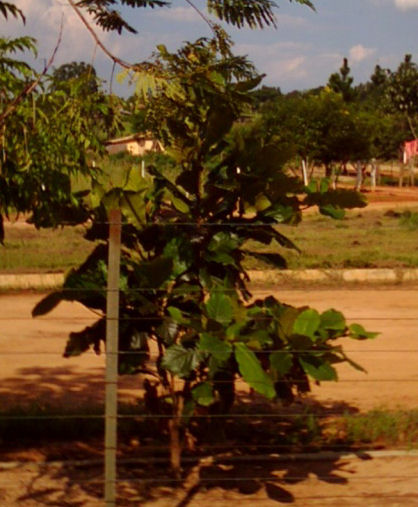

Terminalia catappa (Beach Almond, Indian Almond)
A 67 to 83 feet tall deciduous tropical tree from the genus Terminalia and from the family Combretaceae, native to Malaysia, in the Western Pacific to West Africa. They have a lively, horizontal branching, leading to an open-spreading crown. The shoots are not from butress roots, the root system does not spread excessively. The flexible timber is reddish with a folded and twisted grain. In the fall the broad and simple, to 12 inches long, leaves discolor yellow and later deep red.
The Indian almond trees are monoecious unisexual. During the summer and fall months are arranged on the branches, axillary, 2.4 to 6.4 inches long spikes are forming. The upper flowers of the inflorescence are mal e, the lower hermaphrodite. The nondescript, small, greenish white, fragant flowers are unisexual or bisexual, and fivefold. The sepals are 1 to 1.5 mm long. Petals absent. Male flowers have a 1.5 to 2.5 mm long flower stalk. There are two circles, each with five 2 to 2.5 mm long stamens present. The pen is up to 2 mm long. The pollen is carried by insects. There are only yellow, at maturity reddish 1.6 to 2.4 inches long and 0.8 to 1.2 inches wide, two-winged, edible nut fruits forming.
In Asia and Africa the species is often planted as a shade giver. The wood is used as a timber, has a pleasant smell, is also used for boat and house construction. The wood can be soaked in water and a yellow color can be producted from the bark or black color is obtained, both solutions are used as colorants.
The bark is also used for medical purposes, for example to treat diarrhea, the veneral disease gonorrhea, typhoid fever and stomach cramps. Dried leaves are used medicinally.
The pericarp and the core of the fruit are edible, but the shell is very tough and must be removed first, often this is not easy.
Our specimen we overtaken by the purchase of our yard and was recognized promptly, I know this species from the island Tenerife, in the north of Puerto de la Cruz there are some planted as street trees.

Terminalia catappa as street tree at the border of our yard in
August 2008.
Back to the Agricultural Plant List
Created by Joachim Jaeck on December 1st, 2009